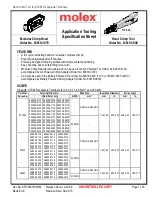
North American Clutch & Driveline
Rockford, Illinois
Phone: (800) 383-9204
(815) 282-7960
Fax (815) 282-9160
www.naclutch.com
3.3 Bearing Operating Temperature
3.3.1 Main Bearing
Operating temperature range is normally between 170°F. and 200°F. (76.7°C. to
93.3°C.). Locations with high ambient temperatures such as desert climates will cause
the bearings to operate at a higher temperature. More frequent lubrication intervals
and/or specialized grease designed for higher operating temperatures will be required.
See following note.
Note: There is a tendency to test temperature with the hand However, it is difficult
to hold a hand on a bearing housing operating at 150°F. (65.6°C.), although that
temperature is below the normal 170°F. (76.7°C.) operating temperature of the PTO.
Therefore a thermometer (contact type) should be used to make reasonably accurate
temperature measurements.
3.4 Methods of measuring clutch engagement force:
The model 14” HD, 14” HD (DP), and 14” HD(TP) clutches described in this manual do
not automatically adjust to compensate for wear of the clutch facing(s), and therefore
must be manually adjusted. Maintaining the correct engagement pressure is the
responsibility of the owner/operator. The owner/operator must periodically adjust the
clutch to ensure correct clutch operation. See section 3.5.
The clutch should be adjusted if the force required to engage the clutch drops by
10-15% of the specified engagement force. Destructive damage may have already
occurred if engagement force is allowed to diminish to the point where the clutch fails
to carry the load (slippage), or if facing(s) have over heated.
Caution: Torque wrench readings are in FOOT-POUNDS, which are different values from
spring scale readings which are in POUNDS OF FORCE. There is no direct correlation
between FOOT-POUNDS and POUNDS OF FORCE. Do not confuse the two different
kinds of values.
Note: New clutches or new facings usually require several, frequent adjustments until
the friction facing surfaces have “worn in”. The clutch friction facing plate(s) will become
glazed, and possibly permanently damaged if the clutch is permitted to slip excessively.
Note: If the facings have been slipped excessively, and enough heat was generated that
the facings began to smoke, the clutch material may have been destroyed. Excessive
heat normally destroys the friction material. Therefore further clutch adjustment will not
remedy slippage problems, replace “burned” facing plates.
9















































